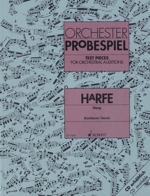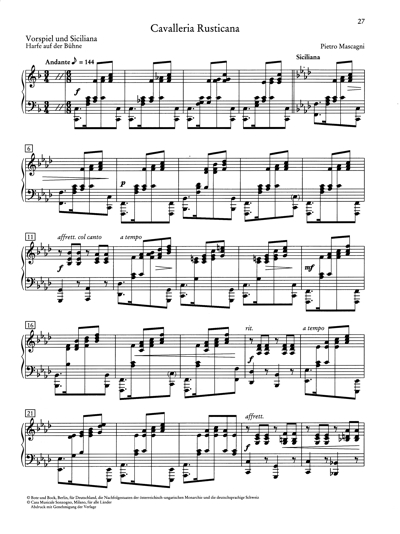 |
Orchester Probespiel Test Pieces for Orchestral Auditions HARP Ed. Ruth Konhäuser & Helga Storck |
|
| Contents: | See Contents below | |
| Instrumentation: | Pedal Harp | |
| Level: | Advanced | |
| Format: | 9" x 12" bound score | |
| ISMN: | 9790001081443 | |
| Publisher: | Schott | |
| Edition/Year: | 2012 | |
| Origin: | Germany | |
| Our Ref: | UM1335 | |
Buy this music now £31.50 +p&p |
||
| Other music by Helga Storck | ||
| Other music by Ruth Konhauser | ||
| CONTENTS | |
| Bela Bartok | Musik fiir Saiteninstrumente, Schlagzeug und Celesta |
| Concerto for Orchestra | |
| Hector Berlioz | Symphonie Fantastique op. 14 |
| Benjamin Britten | The Young Person's Guide to the Orchestra |
| Anton Bruckner | Sinfonie Nr. 8 c-Moll |
| Gaetano Donizetti | Lucia di Lammermoor |
| Cesar Franck | Sinfonie d-Moll |
| Hans Werner Henze | Ondine |
| Ruggiero Leoncavallo | Der Bajazzo |
| Pietro Mascagni | Cavalleria Rusticana |
| Maurice Ravel | Alborada del Gracioso |
| Tzigane | |
| Klavierkonzert G-Dur | |
| Bedfich Smetana | Mein Vaterland |
| Richard Strauss | Don Juan op. 20 |
| Salome op. 54 | |
| Salomes Tanz | |
| Ein Heldenleben op. 4 | |
| Igor Strawinsky | Symphony in Three Movements |
| Ambroise Thomas | Mignon |
| Peter Tschaikowsky | Schwanensee op. 20 |
| Der Nußknacker op. 71 | |
| Giuseppe Verdi | Ein Maskenball |
| Die Macht des Schicksals | |
| Aida | |
| Richard Wagner | Tannhauser |
| Die Meistersinger von Nurnberg | |
| Tristan und Isolde | |
| Die Walkure | |
| Carl Maria v. Weber | Aufforderung zum Tanz op. 65 |
Orchester Probespiel
Test Pieces for Orchestral Auditions
HARP
Ed. Ruth Konhäuser & Helga Storck
Preface
For many years orchestras and conservatories have wanted a practical and easily accessible edition of the orchestral passages required at auditions. An orchestral musician is expected to know and to have mastered not only the solo literature of his instrument but especially the opera and concert repertoire as well. The present edition contains those passages which a musician is expected to have at his or her command before being accepted into an orchestra. Unlike the many existing "orchestral studies", this collection focuses on the material commonly used in auditions. It thus forms a foundation for the practical training of young orchestral musicians, and serves professional musicians as a means of practicing difficult passages.
This project was initiated at the behest of the German Music Council and the German conservatories. It is based on statistical studies carried out by the German Union of Orchestras and on many years of professional experience gained by the editors themselves, all of whom are members of orchestras and conservatory staffs.
The following editorial principles underlie the entire series: The original text of the music and the original metronome marks have been taken over without modification; editorial additions are enclosed in square brackets. Measure numbers and rehearsal numbers or letters have been included from the orchestral material. Cuts at the beginning, middle or end of a passage are indicated by intervening slashes.
It goes without saying that the passages included here should always be viewed in the overall context of the piece in question. To augment these studies we strongly advise studying the scores and listening to the music.
C. F. Peters, Frankfurt B. Schott's Sohne, Mainz
Editor's Preface
The present collection contains the most common audition pieces for harp which were suggested and discussed in consultation with harpists of renowned orchestras and the "Vereinigung Deutscher Harfenisten e.V." (registered society of German harpists). Passages for two harps in the operatic literature have been omitted as in orchestras with two harpists these are usually coordinated. Pedalling has been omitted, occasionally (e. g. in "Salome's Dance" by R. Strauss) in favour of clarity and the individuality of the player. With regard to the works by Richard Wagner, it is noteworthy that his writing is not always suited to the instrument. There is evidence that Wagner approved of stylistically appropriate arrangements (similarly Strauss and Tchaikovsky).
A word to those responsible for harp auditions: before the performance, please bear in mind that the harpist, as a rule, must play an unfamiliar instrument; quite on the contrary to all other instrumentalists, who always bring their own best instrument to an audition. Harps are built differently. The sound box may be wide or narrow, above all the seven pedals are often adjusted differendy on each instrument. As a result it is sometimes difficult to play a passage with much pedal movement - e.g. "Feuerzauber" by Wagner or "Tzigane" by Ravel - at the first attempt on the audition instrument. A suitable practice time is therefore recommended. Concerning the performance of the solo pieces, it should be considered that the artistic standard of the candidate will be better displayed if either the concerto or the solo piece may be chosen freely; so only one piece should be set. The freely chosen work should, however, belong to a different stylistic period.
Example 1: set piece: Mozart
concerto
free choice: solo work from another period, e. g. Hindemith sonata, Faure impromptu or Spohr fantasy
Example 2: set piece: Hindemith sonata
free choice: concerto from another period, e. g. Handel concerto (original), Debussy Danses or the Mozart concerto
Editors Ruth Konhauser and Helga Storck
